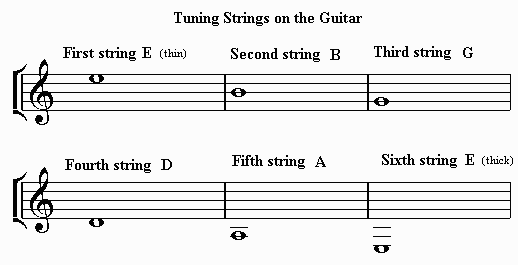
One of the challenges of playing the guitar is to keep the instrument in tune. For some reason this topic is never covered very well in most of the " How To Play Guitar In 3 Easy Lessons " books. Yet it is one of the most fundamental things we Guitarists should know about. Even before we strum our first E chord we should make sure our instrument is in tune. How will you know if that E chord really is an E chord unless the instrument is tuned properly.
One of the frustrating things I found when I was learning how to play ( I think it was yesterday !!) was trying to stay in tune. The other frustration was what to do when you broke a string. Anyway, there are many ways to tune a guitar. Here are some examples:
Buy A Guitar Tuner
Well that was easy wasn't it !! Seriously now, a guitar tuner is a must for anyone playing guitar, from beginner to professional. There are times when your ears or the instrument will just refuse to co-operate. For the professional, trying to tune in a noisy environment can be a pain. Not only that, but by leaving the tuner on during the gig you can check your tuning while you play. For the beginner, a tuner will mean that those first time chord progressions will at least be in tune, and let you get on with the practicing. Tuning strictly by ear alone will take time to master. To hear how the chords should sound when in tune, is actually more beneficial while learning.
Buy A Tuning Fork
This is one of the easiest and cheapest ways to tune a guitar. To tune the guitar you need to tune one string first, then , you tune the other strings to the tuned string. By purchasing a tuning fork usually " A 440 " or " E ", you can tune the first string to the tuning fork. If you have an E fork, you would tune the open first string to match the pitch of the fork, or if you have an A tuning fork, tune the note on the 5th fret on the first string to the fork. Always tune up to the note so that the string tension is kept tight, rather than tuning down to the note, as the string is more likely to detune as the string tension is slackened.
We now have a reference point to tune the other strings. We could also have tuned our first string to any in tune instrument, such as a keyboard if one is handy. The GOOD thing about a tuning fork is that it is compact, fits in the guitar case, never needs batteries, and only costs a few dollars. To hear the note properly from the fork, make sure you place in on the guitar body after it has been struck to increase the volume. Take my advice and don't buy those buzzy little pitch pipes they will try to sell you, a complete waste of time. I've never heard one yet that came close to being in tune, and never ever play one near a bee hive !!
Tuning in Unisons
Now that we have our first string in tune, ( that is unless we broke it while trying to tune it !) we can now tune the second string " B ". Play the note on the 5th fret of the " B " string. This is the note " E " which we will now tune to the first string played open, which is also an " E ". You can hear a slight vibration as the two notes start to get close to matching each others pitch. When the exact pitch has been reached the vibration ( or wavering sound ) will level off to a steady even note. The idea is to play both strings together, then while they are both ringing, tune the untuned string up to the pitch of the in tune string.The next step is similar except that we are going to play the note on the fourth fret of the third string. This is the note " B ", which we now want to tune to the open second string " B ".
Now we play the note on the fifth fret on the fourth string. This is the note " G " , which we tune to the open third string " G ".
Move on to the fifth fret on the fifth string. This is the note " D ", which we tune to the open fourth string " D ".
Finally we play the fifth fret on the sixth string, which is the note " A " which we tune to the open fifth string " A ".
OK, so now we are in tune right !, play an E chord. TWWAANNGGGG..... (Please refer to section " Buy a Guitar Tuner !!" or check out the diagrams below and start over again.)
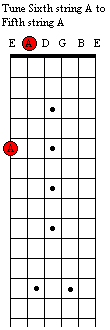 |
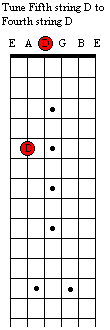 |
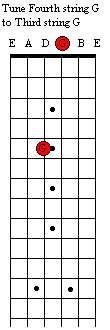 |
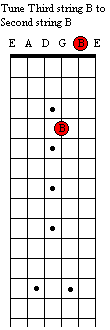 |
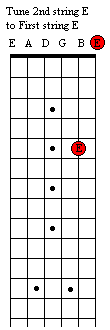 |
When you are satisfied that guitar now sounds reasonably in tune using the above method, check the overall tuning by playing octaves in various positions all over the neck. One method I find that works well, is to check the tuning of each string to the first string. For example play the second string B with the B on the first string on the 7th fret, then the third string G with the G on the first string on the 3rd fret, the fourth string D with the D on the first string on the 10th fret, the fifth string A with the A on the first string on the 5th fret and the sixth string E with both the first string open E and at the E at the 12th fret. By applying a few different tuning methods one can achieve the best relative pitch over the entire neck of your instrument.
Tuning by Chords
The ultimate test as to whether you have tuned the instrument properly is to play chords in different positions on the neck. If the chords don't sound right, make the necessary adjustments to correct the overall sound of the chord. Guitar necks are never perfect, so there will always be some minor intonation problems in getting your instrument in tune. Trust your ear to make the necessary adjustments to fine tune the chords you are playing. Often chords are in tune when played in the first couple of frets ,however they may not sound too good up on the 10th fret. Try to strike a balance which best suits your playing and your instrument.
If you really have problems tuning, it could be that the guitar neck is warped or in need of some other repair or adjustment. Unless you know what you are doing these adjustments are best left to the experts.
Another popular tuning method is to Tune by using Harmonics.